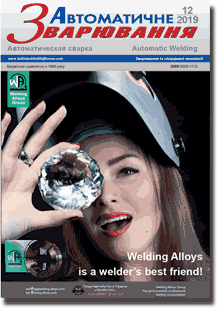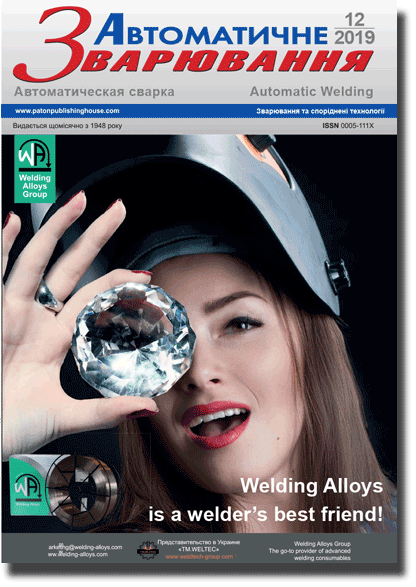| 2019 №12 (05) |
DOI of Article 10.15407/as2019.12.06 |
2019 №12 (07) |

"Avtomatychne Zvaryuvannya" (Automatic Welding), #12, 2019, pp.52-60
Effect of extrusion modifiers of coating mass on variation of electrode coating thickness
A.Yu. Marchenko1, M.F. Gnatenko2, M.V. Skorina1
1E.O. Paton Electric Welding Institute of the NAS of Ukraine, 11 Kazymyr Malevych Str., 03150, Kyiv, Ukraine. E-mail: office@paton.kiev.ua
2WELMA Co. Ltd., 3 Kaunasskaya Str., 02160, Kyiv
The method of oscillographing the signals generated by electromagnetic sensor, through the channel of which the electrodes pass at the outlet of the press coating head, was used to study the effect of extrusion modifiers of the coating mass on thickness variation in manufacture of test electrodes UONI 13/55 of 4 mm diameter. The phenomenon of reduction of coating thickness variations under the effect of modifiers (CMC, alginates, cellulose or soda ash) is explained by that the dose of liquid glass added to the coating gradually increases with the change of the type and increase of the content of modifier. Hydrating of modifying additive particles as a result of absorption of liquid glass moisture leads to thickening of the glass, and of its intergranular layers in the coating mass, and to weakening of Hamaker interaction of filler grains. Probability of generation and accumulation of elastic stresses during extrusion application of the coating on the rods becomes lower. The ability of the coating flow to cover the rods in a uniform concentric layer at pressing of the electrodes becomes higher, accordingly. 6 Ref., 1 Tabl., 11 Fig.
Keywords: coated electrode production, coating mass, coating thickness variation, extrusion modifiers, liquid glass, coating viscosity, electrode quality
Received: 17.09.2019
Published: 17.12.2019.
References
1. Marchenko, A.E. (2017) Experimental studies of electrode coating thickness variation at pressing. The Paton Welding J., 1, 20-27. https://doi.org/10.15407/tpwj2017.01.032. Bernhardt, E. (1965) Recycling of thermoplastic materials. Moscow, Khimiya [in Russian].
3. Lavrenov, L.V., Marchenko, A.E., Shkurko, S.A (1975) Peculiarities of adsorption of alkaline silicates from liquid glass by marble and fluorite in electrode coatings. Avtomatich. Svarka, 3, 34-38 [in Russian].
4. Marchenko, A.E., Skorina, N.V. (2013) Influence of technological factors in manufacture of low-hydrogen electrodes on hydrogen content in the deposited metal. The Paton Welding J., 8, 13-24.
5. Marchenko, A.E., Gnatenko, M.F., Gorshkova, S.D. (1984) Method of evaluation of thermal softening of electrode paste. In: Inform. documents, CMEA, 1, 66-69 [in Russian].
6. Shelepov, E.P. (2000) Furnace of G-232 model for heat treatment of welding electrodes. In: Proc. of Sci.-Techn. Seminar on Electrode Manufacture on the Threshold of New Millennium (St.-Petersburg, 22-26 May, 2000). Cherepovets, 170-175 [in Russian].
The cost of subscription/purchase order journals or individual articles
| Journal/Currency | Annual Set | 1 issue printed |
1 issue |
one article |
| TPWJ/USD | 384 $ | 32 $ | 26 $ | 13 $ |
| TPWJ/EUR | 348 € | 29 € | 24 € | 12 € |
| TPWJ/UAH | 7200 UAH | 600 UAH | 600 UAH | 280 UAH |
| AS/UAH | 1800 UAH | 300 UAH | 300 UAH | 150 UAH |
| AS/USD | 192 $ | 32 $ | 26 $ | 13 $ |
| AS/EUR | 180 € | 30 € | 25 € | 12 € |
| SEM/UAH | 1200 UAH | 300 UAH | 300 UAH | 150 UAH |
| SEM/USD | 128 $ | 32 $ | 26 $ | 13 $ |
| SEM/EUR | 120 € | 30 € | 25 € | 12 € |
| TDNK/UAH | 1200 UAH | 300 UAH | 300 UAH | 150 UAH |
| TDNK/USD | 128 $ | 32 $ | 26 $ | 13 $ |
| TDNK/EUR | 120 € | 30 € | 25 € | 15 € |
AS = «Automatic Welding» - 6 issues per year;
TPWJ = «PATON WELDING JOURNAL» - 12 issues per year;
SEM = «Electrometallurgy Today» - 4 issues per year;
TDNK = «Technical Diagnostics and Non-Destructive Testing» - 4 issues per year.





